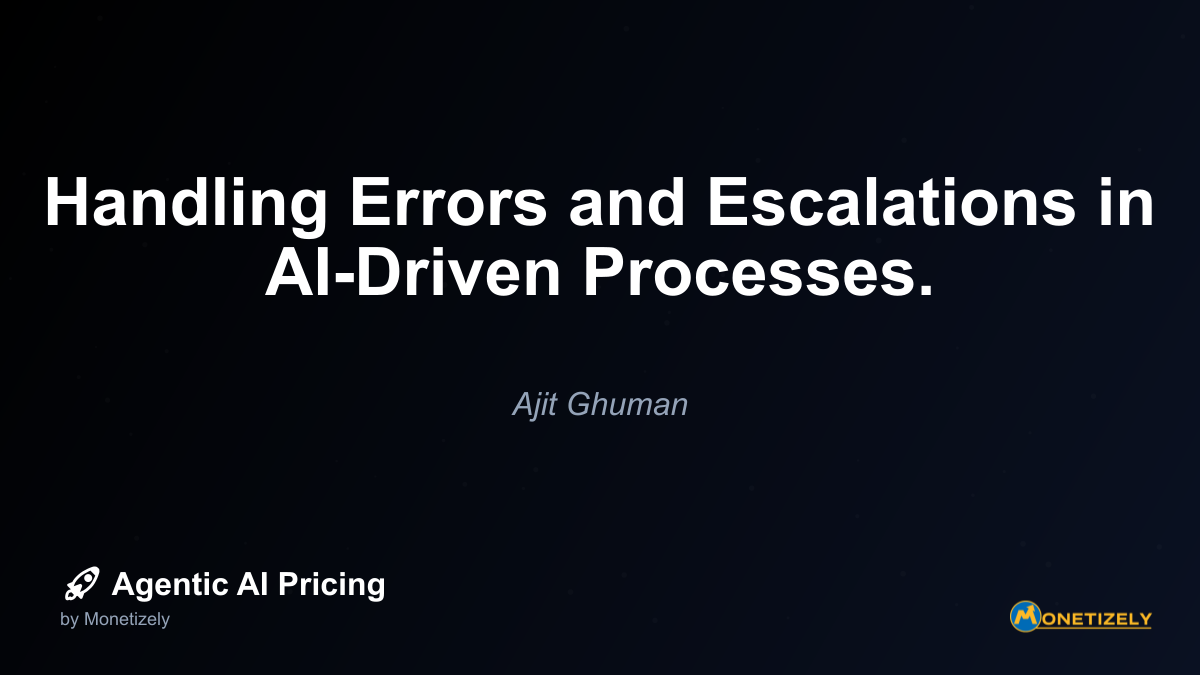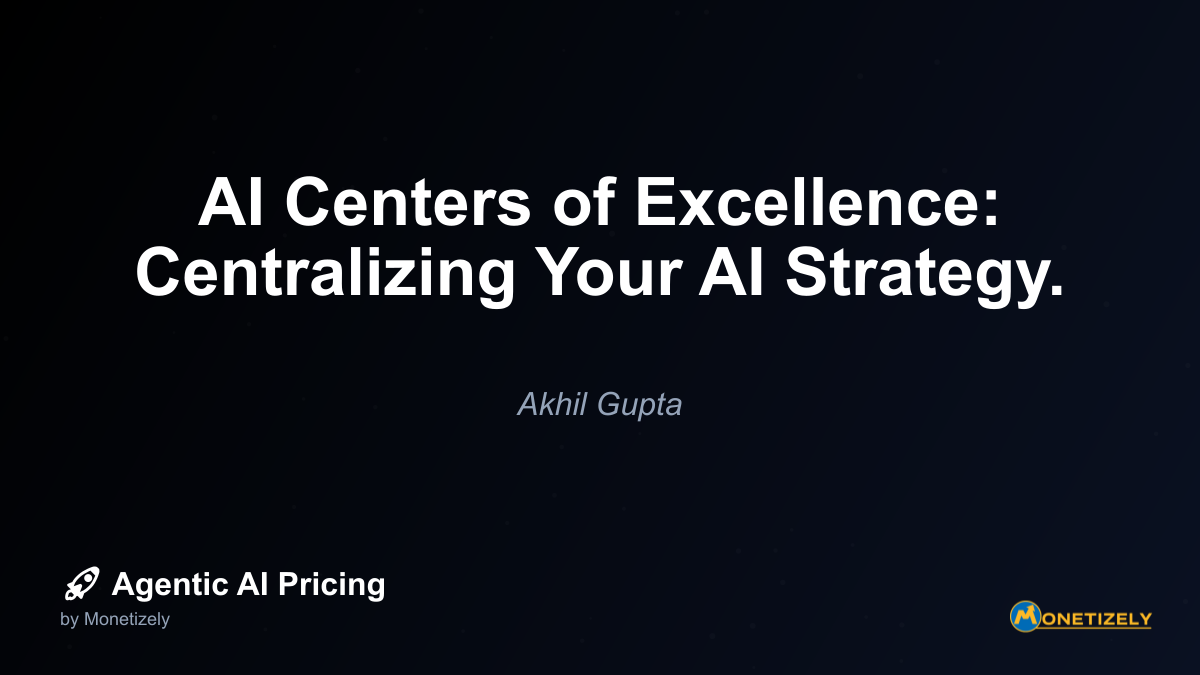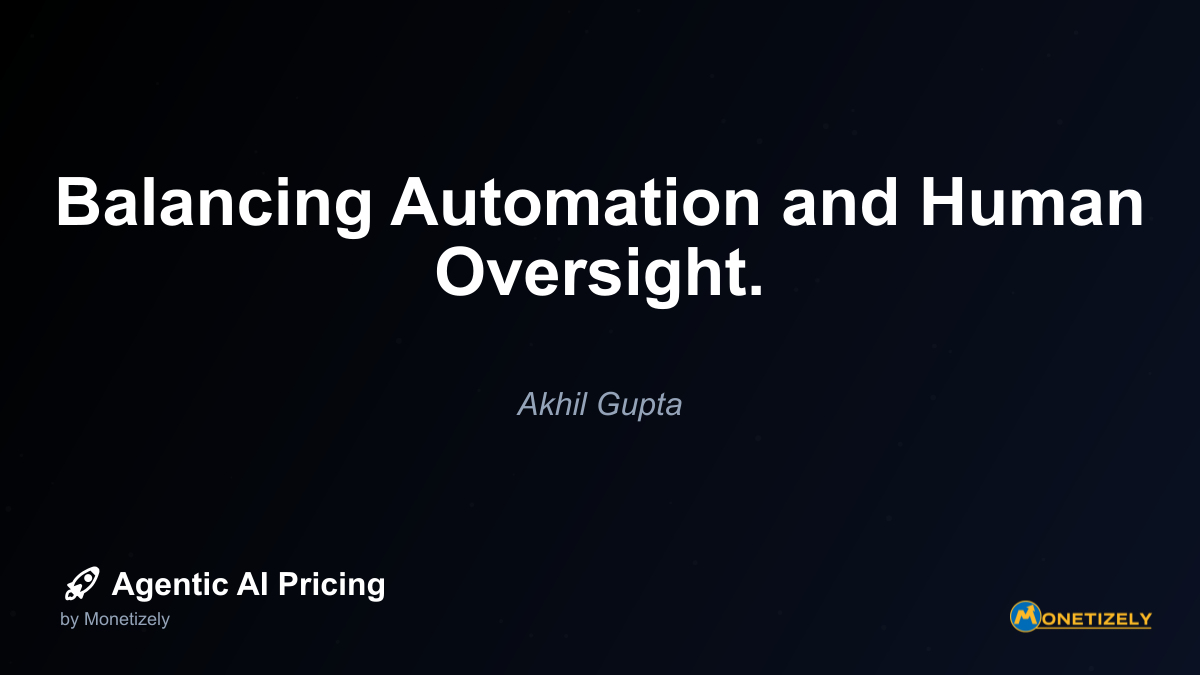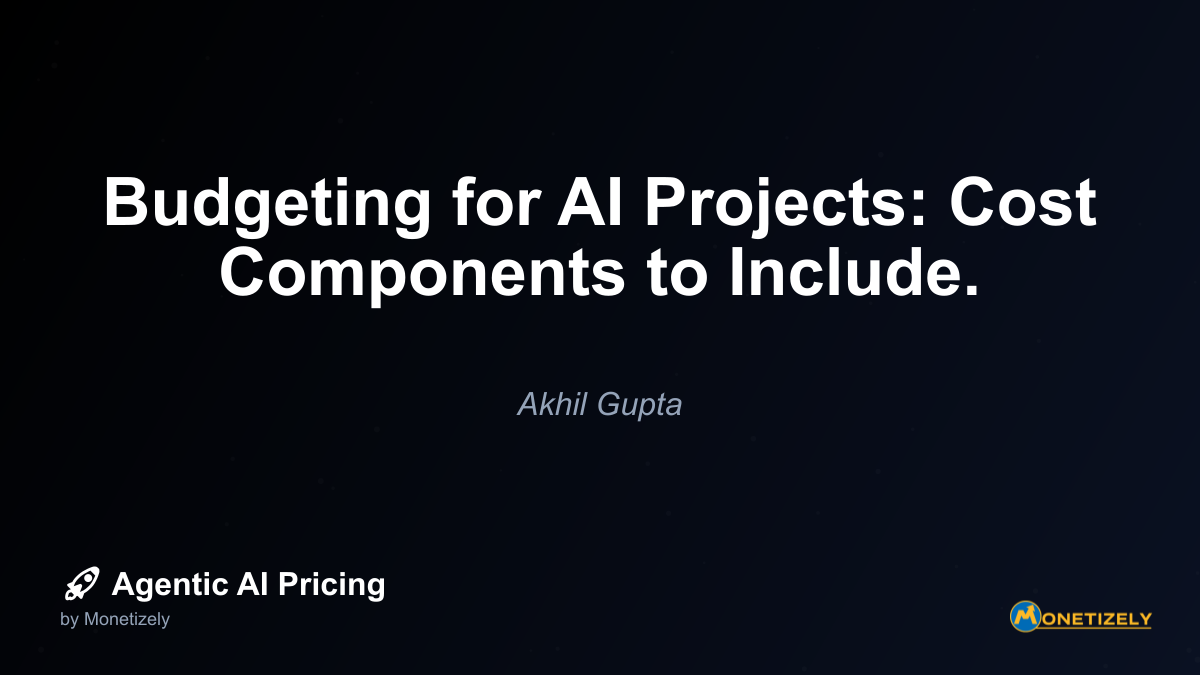· Ajit Ghuman · Implementation Strategies · 8 min read
Handling Errors and Escalations in AI-Driven Processes.
AI and SaaS Pricing Masterclass
Learn the art of strategic pricing directly from industry experts. Our comprehensive course provides frameworks and methodologies for optimizing your pricing strategy in the evolving AI landscape. Earn a professional certification that can be imported directly to your LinkedIn profile.

In today’s rapidly evolving landscape of artificial intelligence, even the most sophisticated AI agents will inevitably encounter situations beyond their capabilities. As organizations increasingly deploy autonomous AI systems to handle complex tasks, the question isn’t whether errors will occur, but rather how effectively these systems can recognize their limitations and gracefully transition to appropriate fallback mechanisms.
Effective error handling and escalation pathways represent the crucial safety net that allows AI-driven processes to maintain service continuity and quality even when faced with unexpected challenges. This is particularly important as AI agents take on more mission-critical roles across industries—from customer service to financial operations to healthcare support.
Why Error Handling Matters in AI-Driven Processes
The promise of AI automation lies in its ability to handle routine tasks efficiently while freeing human resources for higher-value work. However, this promise quickly unravels when AI systems encounter edge cases, ambiguous inputs, or scenarios they weren’t trained to handle. Without proper error detection and escalation protocols, these situations can lead to:
- Degraded customer experiences
- Operational bottlenecks
- Potential compliance violations
- Loss of user trust
- Increased operational costs
Research from the MIT Sloan Management Review indicates that organizations with mature AI implementation strategies dedicate significant resources to designing robust error-handling frameworks. These frameworks don’t just prevent failures—they transform potential points of breakdown into opportunities for system improvement and learning.
Types of Errors in AI-Driven Processes
Before designing escalation pathways, it’s essential to understand the different categories of errors that might occur in AI operations:
1. Knowledge Boundary Errors
These occur when an AI agent encounters a query or task that falls outside its training domain. For example, a financial AI assistant might be well-versed in personal banking but unable to address complex corporate treasury questions.
2. Confidence Threshold Errors
Many AI systems generate confidence scores alongside their outputs. When these scores fall below predetermined thresholds, it signals uncertainty that may warrant human intervention.
3. Logical Consistency Errors
These happen when an AI produces outputs that, while seemingly reasonable in isolation, create contradictions when viewed holistically. For instance, an AI might approve a transaction that violates business rules it had previously enforced.
4. Execution Failures
Technical issues such as API timeouts, data access problems, or computational resource limitations can prevent an AI from completing its assigned tasks.
5. User Communication Breakdowns
These errors occur when the AI cannot effectively understand user inputs despite multiple attempts, creating frustrating loops of misinterpretation.
Designing Effective Escalation Pathways
Creating robust escalation mechanisms requires thoughtful planning that balances operational efficiency with service quality. Here’s a framework for designing these critical pathways:
Define Clear Escalation Triggers
Every AI system should have explicit conditions that trigger escalation. These might include:
- Confidence scores below defined thresholds
- Multiple failed attempts to complete a task
- Detection of high-stakes decisions (e.g., transactions above certain values)
- Explicit user requests for human assistance
- Pattern recognition of circular conversations
These triggers should be continuously refined based on operational data and user feedback.
Create Tiered Response Mechanisms
Not all errors require immediate human intervention. A tiered approach allows for proportional responses:
Tier 1: AI Self-Correction The system attempts to resolve the issue independently by:
- Rephrasing questions to users
- Accessing additional knowledge bases
- Applying alternative problem-solving approaches
Tier 2: AI-to-AI Escalation When one AI agent reaches its limitations, it transfers the task to a more specialized AI system with relevant expertise.
Tier 3: AI-Augmented Human Support Human operators receive the case along with AI-generated context, recommended actions, and relevant background information.
Tier 4: Full Human Takeover For the most complex or sensitive cases, human specialists assume complete control with minimal AI assistance.
Implement Graceful Transitions
The handoff between AI systems or from AI to human operators represents a critical moment in the user experience. Effective transitions should:
- Maintain conversation context and history
- Clearly communicate the reason for escalation
- Set appropriate expectations for resolution timeframes
- Preserve user data and interaction history
- Provide a seamless experience across channels
Design for Learning and Improvement
Each escalation event contains valuable data that can strengthen the overall system. Implement feedback loops that:
- Document the specific triggers that prompted escalation
- Capture resolution pathways for similar future cases
- Identify patterns that might indicate training gaps
- Measure resolution efficiency and customer satisfaction
- Feed successful resolution strategies back into AI training
Technical Implementation Considerations
Translating escalation frameworks into functional systems requires attention to several technical aspects:
Monitoring and Detection Systems
Implement comprehensive monitoring that can detect potential issues before they become critical failures:
- Real-time performance metrics
- Anomaly detection algorithms
- Sentiment analysis of user interactions
- System resource utilization tracking
- Response time monitoring
Integration Architecture
Effective escalation depends on seamless connections between systems:
- API-based communication between AI components
- Unified data repositories for context preservation
- Secure authentication for human operator access
- Cross-platform compatibility for omnichannel support
- Webhook support for third-party integrations
Human Interface Design
The tools provided to human operators who receive escalated cases should:
- Present comprehensive context without overwhelming detail
- Highlight specific failure points that triggered escalation
- Provide quick-access tools for common resolution paths
- Enable efficient documentation of resolution actions
- Support knowledge transfer back to AI systems
Industry-Specific Considerations
Different sectors face unique challenges when implementing AI escalation frameworks:
Financial Services
Financial institutions must balance efficiency with strict regulatory compliance:
- Maintain detailed audit trails of all escalation events
- Implement mandatory human review for transactions above risk thresholds
- Ensure escalation pathways meet regulatory requirements for customer protection
- Design fail-safes that prevent unauthorized transactions during system transitions
Healthcare
Patient safety and data privacy concerns dominate healthcare AI implementations:
- Create immediate escalation protocols for any potential patient safety issues
- Ensure HIPAA compliance throughout the escalation process
- Implement clinical validation steps for AI-suggested medical actions
- Design systems that err on the side of caution when uncertainty exists
Customer Service
In customer-facing applications, preserving a positive experience during escalation is paramount:
- Minimize wait times during transitions to human operators
- Maintain conversation context to prevent customers from repeating information
- Provide human agents with complete interaction history
- Design escalation language that doesn’t undermine trust in the overall service
Measuring Escalation Effectiveness
To continuously improve escalation processes, organizations should track key performance indicators:
Operational Metrics
- Escalation rate (percentage of interactions requiring escalation)
- Resolution time (average time to resolve escalated issues)
- First-contact resolution rate (issues resolved without further escalation)
- Automation recovery rate (percentage of cases where AI successfully self-corrects)
Customer Experience Metrics
- Customer satisfaction scores for escalated interactions
- Net Promoter Score variations between AI-only and escalated interactions
- Customer effort scores (measuring ease of resolution)
- Abandonment rates during escalation processes
Cost and Efficiency Metrics
- Cost per resolution (comparing AI-only vs. escalated interactions)
- Agent utilization efficiency
- Knowledge capture rate (percentage of resolutions that improve AI training)
- Time savings from AI-augmented human support
Common Pitfalls and How to Avoid Them
Even well-designed escalation systems can encounter challenges. Here are frequent issues and strategies to address them:
1. Escalation Overload
Problem: Too many cases are escalated, overwhelming human operators and negating the efficiency benefits of AI.
Solution: Regularly refine escalation triggers based on resolution data, implement pre-escalation review by specialized AI models, and continuously expand AI training to handle common escalation causes.
2. Disjointed User Experience
Problem: Users experience jarring transitions between AI and human support, creating frustration and confusion.
Solution: Design seamless handoffs with consistent communication styles, implement warm transfers where the AI introduces the human operator, and ensure all context is preserved across the transition.
3. Escalation Avoidance
Problem: AI systems attempt to handle cases beyond their capabilities rather than triggering appropriate escalation.
Solution: Implement “fail fast” principles that reward appropriate escalation, create clear confidence thresholds, and avoid penalizing AI performance metrics for necessary escalations.
4. Resolution Silos
Problem: Successful human resolutions aren’t captured to improve AI capabilities, creating repetitive escalation patterns.
Solution: Implement systematic knowledge capture from human resolutions, create dedicated feedback loops from support teams to AI development, and regularly analyze escalation patterns.
Building a Culture of Continuous Improvement
Effective error handling extends beyond technical implementation to organizational culture. Organizations that excel in this area typically:
- Treat escalations as valuable learning opportunities rather than system failures
- Celebrate appropriate escalations that prevent potential issues
- Involve human operators in AI training and improvement
- Maintain cross-functional teams spanning AI development and operational support
- Regularly review escalation patterns to identify systemic improvements
Future Trends in AI Error Handling and Escalation
As AI technology continues to evolve, several emerging approaches promise to enhance escalation effectiveness:
Predictive Escalation
Rather than waiting for failures to occur, advanced systems are beginning to predict potential failure points and proactively initiate escalation or preventive measures.
Collaborative Resolution
Instead of binary handoffs between AI and humans, newer models support collaborative problem-solving where AI and human operators work simultaneously on different aspects of complex issues.
Emotional Intelligence in Transitions
Sophisticated sentiment analysis is enabling systems to detect user frustration earlier and adapt escalation timing and approaches based on emotional context.
Personalized Escalation Pathways
As systems gather more interaction data, they can develop user-specific escalation models that adapt to individual preferences and problem-solving styles.
Conclusion
In the rapidly evolving landscape of AI-driven processes, robust error handling and escalation pathways aren’t optional features—they’re fundamental requirements for operational resilience. Organizations that invest in thoughtfully designed escalation frameworks gain not just a safety net for AI limitations, but a powerful mechanism for continuous system improvement.
The most successful implementations recognize that human-AI collaboration represents a spectrum rather than a binary choice. By creating fluid transitions between autonomous operation and human intervention, organizations can leverage the strengths of both while mitigating their respective limitations.
As AI capabilities continue to expand, paradoxically, the design of effective fallback mechanisms becomes more critical. The organizations that thrive will be those that embrace this apparent contradiction, building systems that are simultaneously ambitious in their automation goals and realistic about the enduring need for human judgment in complex situations.
By approaching error handling and escalation as strategic capabilities rather than necessary evils, forward-thinking organizations can transform potential points of failure into powerful differentiators that enhance customer trust, operational efficiency, and competitive advantage.
Co-Founder & CEO
Ajit is the author of Price To Scale, a top book on SaaS Pricing and is the Founder of Monetizely. Ajit has led and worked in pricing and product marketing at firms like Twilio, Narvar and Medallia. His work has been featured in Forbes and VentureBeat. Ajit regularly consults with software companies from Seed stage to post-IPO on pricing strategy. Ajit is also a highly-rated co-instructor for 'The Art of SaaS Pricing and Monetization' on Maven.
Pricing Strategy Audit
Let our experts analyze your current pricing strategy and identify opportunities for improvement. Our data-driven assessment will help you unlock untapped revenue potential and optimize your AI pricing approach.




